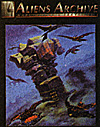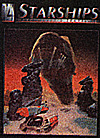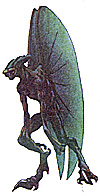Aliens Archive by Timothy Brown ($22.95, 106 pgs)
Central Supply Catalog by Greg Porter ($22.95, 93 pgs)
Starships by Don Perrin ($20, 107 pgs)
The three newest Traveller books fill in some of the gaps left by the core rulebook, providing players with detailed alien races, ship and vehicle design rules, and plenty of equipment to outfit characters with. Each book is very well-written, but suffers from Traveller's trademarked lack of graphical flair. Illustrations are typically not placed into the text, but set aside on their own pages, leaving vast expanses of plain-looking words behind. The artwork is all high-quality - especially the color plates - making the plain layout that much more of a shame.
Quibbles with layout decisions aside, each book has something to offer the hard-core sci-fi gamer. Don't be put off by the plain appearance, but be prepared for sticker shock - these books are expensive.
 The Aliens Archive has detailed descriptions of ten lesser alien races - those who have not developed interstellar travel on their own. Each race has approximately ten pages devoted to it, which is ample room to go into great detail on their physiology, psychology, culture, and history.
The Aliens Archive has detailed descriptions of ten lesser alien races - those who have not developed interstellar travel on their own. Each race has approximately ten pages devoted to it, which is ample room to go into great detail on their physiology, psychology, culture, and history.
Best of all, the aliens are, well, alien. They are not Star Trek-style humanoids with pointy ears and funny noses, but rather creatures with exotic physiologies and even weirder psychologies. It's easy to invent funny-looking aliens - dozens of games have done so. But it's not easy to create plausible alien psychology and culture from scratch, and that's just what's been done here. Author Timothy Brown has carefully considered each creature's evolution and history, and thoughfully extrapolated how that would determine their disposition as an advanced society.
The results are worth reading for any sci-fi GM. Take, for example, the Hresh. Somewhat resembling Earthly trees, they are a race of sentient autotrophs. Long ago, they evolved the ability to slowly move themselves about as a defense from the floods that would periodically ravage the lowlands of their homeworld. Sentience followed, and today they have a rich, if decidedly low-tech culture. As the Hresh are able to produce their own sustenance from sunlight and water, they are horrified by the thought of sentient beings voluntarily feeding on other creatures. They will be quite vocal about their beliefs, and are considered by most other races to be annoying at mealtimes. The Hresh also have a strong tradition of sheltering and nurturing wildlife. For millenia, creatures similar to Terran insects and birds lived in the branches of the pre-sentient Hresh, and modern Hresh still maintain close ties with many native species.
They only abandon their personal menageries under protest, but this is often necessary before they can book passage on a starship. Hresh communicate via the delicately orchestrated rustling of their branches, and must use translation computers to communicate with other species.
The Hresh are one of the more extreme examples of how odd the aliens in the Aliens Archive can get. Most are slightly more conservative, but the presence of the "real weirdies" is a welcome spice. Interestingly, a couple of races in the book are descended from long-lost human stock, but thousands of years of isolation has wrought great changes upon them, making them as alien as anything else.
Of course, rules are given for making any of the alien races presented into player characters, but in many cases only a devoted and talented roleplayer would want to make the attempt. Most aliens will make better NPCs.
Fortunately, for each alien entry GMs are provided with two stand-alone encounters, so that they can easily introduce new aliens into their campaign. One encounter considers member of the race that the PCs meet on the homeworld; the other details an alien individual who has travelled abroad into the Imperium. This is a nice touch that will make it a lot easier to start using the material right away.
Overall, this is a great book, and probably the best of the new Traveller books. It is also one of the best game supplements of its kind, for any system.
 Starships is a lot less fun to read than Aliens, and is less useful, too. It has statistics and deck plans for 32 starships, from the smallest lifeboat to the largest transport ships. The problem is that half of the ships already made an appearance in the core rule book. To make matters worse, the information provided in Starships is in most cases no more detailed than what one would in the core rules.
Starships is a lot less fun to read than Aliens, and is less useful, too. It has statistics and deck plans for 32 starships, from the smallest lifeboat to the largest transport ships. The problem is that half of the ships already made an appearance in the core rule book. To make matters worse, the information provided in Starships is in most cases no more detailed than what one would in the core rules.
However, each entry has deck plans, which is a nice addition. An exterior illustration is also provided, right alongside the descriptive text. It's a trend they should run with, as this is the best-looking Traveller book so far. All is not perfect, though. The color plates are still hidden in the back and the deck plans lack polish.
The deck plans have yet another problem. The plans provided for largest ships do not show detailed floor plans, but instead present a cross-sectional view. While you get a good sense of how much space is taken up by engines, fuel, weapons, and staterooms respectively, you do not have enough information to conduct a detailed action scenario. It would have been well worth a few more pages - and a few more dollars - to include this information.
Starships has a much more detailed ship creation system, replacing that which is present in the core rules. The new rules in Starships will only be useful to the most hard-core ship designers. More casual players will be able to get by fine with the quick design system in the basic rules.
 Also present are a few high-profile NPC bios, tucked in among the ship descriptions. The characters are interesting, varying from Imperial Navy officers to mercenary captains. They could be dropped into almost any scenario, but explicit story hooks are not given.
Also present are a few high-profile NPC bios, tucked in among the ship descriptions. The characters are interesting, varying from Imperial Navy officers to mercenary captains. They could be dropped into almost any scenario, but explicit story hooks are not given.
In the end, Starships seems to have a lot less to offer the typical player than the Aliens Archive does. Of course how much a GM will get out of it depends on the kind of campaign they're running - for some people the deck plans alone will be worth the price of admission.
The Central Supply Catalog is another one of the less-glamorous tools any RPG line needs. Despite its utilitarian focus, it is still a fun book to read, providing plenty of, "Ooh, I never thought of that" moments. All manner of personal equipment is described, from tech level 2 plate armor to tech level 12 battle dress. In between, players will find items such as the personal atmospheric re-entry kit (AKA "Hell on a Half-Shell"), communications satellites, robots, and survival gear. The entries for spacesuits and the Imperial Surplus Surfaces are especially interesting and useful. Some rules are even given for exposure to vacuum.
A large part of the book is devoted to a vehicle design system, which is actually a variant of that used in Fire, Fusion, and Steel. It also feels a lot like the T4 starship design system, which is no surprise. Over ten example vehicles are provided. They are all useful, but none are especially interesting.
If the books were in the neighborhood of $15 each, it would be easy to suggest buying all of them. However, they are too expensive for that, and T4 players will probably have to prioritize. The Aliens Archive seems to be the best of the lot, being both fun to read an broadly useful. The Central Supply Catalog and Starships are both good books, but do not stand out. Still, T4 is off to a good start.
More Reviews:
-
In Nomine
Shadowrun Companion
Live and Direct
Marc Miller's Traveller (4th Edition)
The Babylon Project
Casting Call (Miniatures)
Unknown Providence
Command and Conquer (computer game)
Cthulhu Live
Back to Shadis #34 Table of Contents
Back to Shadis List of Issues
Back to MagWeb Master List of Magazines
© Copyright 1998 by Alderac Entertainment Group
This article appears in MagWeb (Magazine Web) on the Internet World Wide Web.
Other military history articles and gaming articles are available at http://www.magweb.com